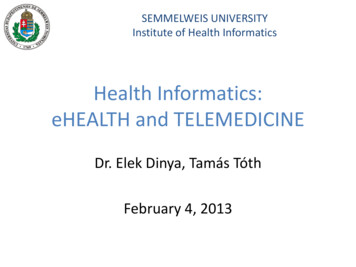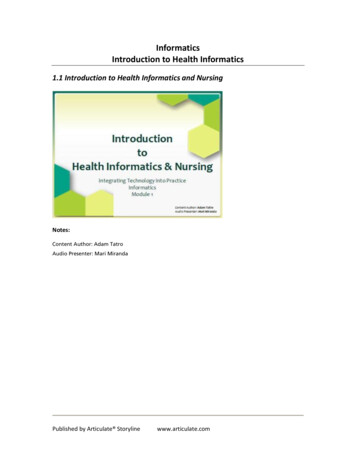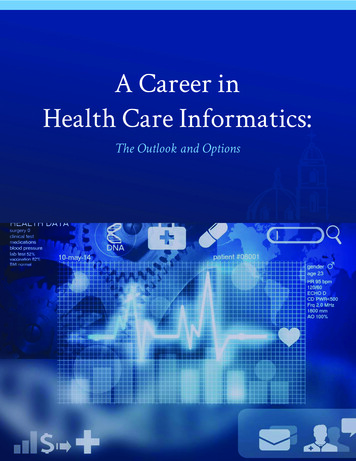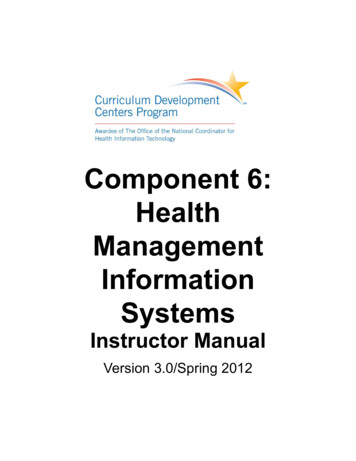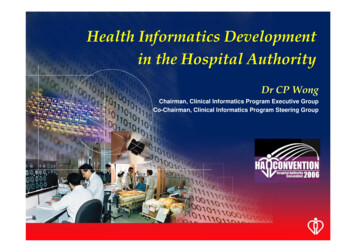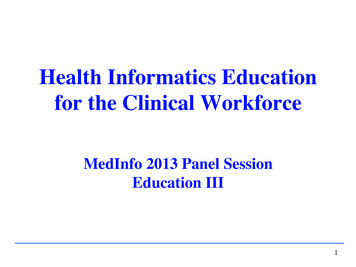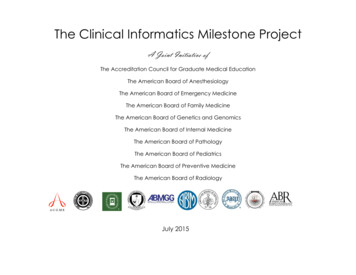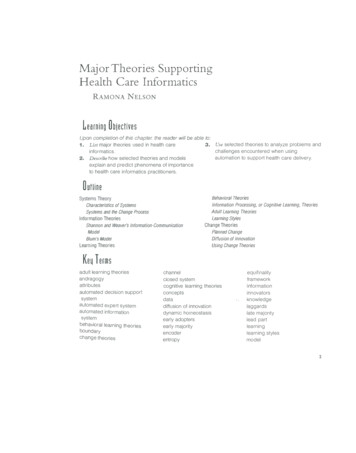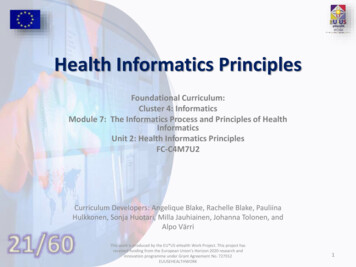
Transcription
Public Health 101 SeriesIntroduction to PublicHealth InformaticsInstructor nameTitleOrganizationNote: This slide set is in the public domain and may be customized as needed by theuser for informational or educational purposes. Permission from the Centers forDisease Control and Prevention is not required, but citation of the source isappreciated.
Course TopicsIntroduction to PublicHealth Informatics1. A Public Health Approach2. Public Health Informatics Definition, Components,and Functions3. Creating a Public Health Information System4. At the Intersection of the Informatician, the PublicHealth Official, and the Information Technologist2
Learning ObjectivesAfter this course, you will be able to explain the importance of informatics to the publichealth mission describe the role of the informatician in publichealth practice differentiate between public health informaticsand information technology3
Topic 1A Public Health Approach4
A Public Health ApproachSurveillanceRisk tation5
Public Health Core Sciences6
Topic 2Public Health Informatics Definition,Components, and Functions7
The Public Health MissionCDC provides crucial scientificinformation that protects ournation against dangerous andcostly health threats8
Public Health Informatics — DefinedPublic health informatics is thesystematic application ofinformation, computer science,and technology to public healthpractice, research, and learningYasnoff WA, O’Carroll PW, Koo D, Linkins RW, Kilbourne EM. Public health informatics: improving and transforming publichealth in the information age. J Public Health Manag Pract 2000;6:67–75.Riegelman R, ed. Public health 101: healthy people—healthy populations. Sudbury, MA: Jones & Bartlett Learning; 2010: 40.9
Building Your Dream HomeElectricianBrick LayerPlumberFramerPainter10
Building Your Public HealthInformation curitySpecialistNetwork Administrator11
Knowledge CheckA tuberculosis outbreak has occurred in 10 states acrossthe country. To increase knowledge of the health threat,CDC uses computer science, technology, and appliedinformation methods that will inform the nation’spopulation about important .A. researchB. health informationC. security measures12
Knowledge CheckInformatics uses public health knowledge toA. broaden the public health knowledge basethrough learningB. improve population health in daily practiceC. further knowledge in public health researchD. all of the above13
Topic 3Creating a Public HealthInformation System14
The InformaticianUnderstands dscapabilities,opportunities, andlimitationsData StandardsPolicy15
Creating a Public Health Information SystemCreating a Public Health Information SystemPublic ofessionalStep 1 — Vision and System PlanningEnvision solutions, opportunities, and application ofinformation technology in public healthBroad knowledge of public health practice, proficiency ininformation technology, and capacity for innovationStep 2 — Health Data Standards and IntegrationDefine and design health data standards andtransformation (e.g., HL7, ICD, SNOMED) and health domainintegration (e.g., ELR, EHR, CMS, HIE, surveillance,demographics, social media)Design and implement databases, tables, columns, dataformats, and keys for linking tables and data to supportdefined health data standards and integrationExpertise in health data standards, database design, anddata linking and integration across health systemsExpertise in relational/SQLdatabases and unstructureddata design and managementStep 3 — Data Privacy and SecurityDefine and implement health data privacy and HIPAAregulationsImplement and enforce data, systems, and communicationsecurityKnowledge of health data privacyUnderstanding information technologysecurity functionsStep 4 — Systems Design and ImplementationDefine and design methods for public health functions, dataelements, data flow, case definitions, and messagemappingImplement information technology for defined functions,data elements, data flow, and case definitionsStep 5 — Visualization, Analysis, and Reporting of HealthDataExpertise in health systemsand data interoperabilityExpertise in managing informationtechnology systems developmentExpertise in public health practice,business intelligence, decisionmaking, and use of analytic softwareCMS Centers for Medicare and Medicaid Services; EHR electronic health record; ELR electronic laboratory record; HIE healthinformation exchange; HIPAA Health Insurance Portability and Accountability Act; HL7 Health Level 7; ICD International Classification ofDiseases; SNOMED Systematized Nomenclature of Human Medicine; SQL structured query language.16
Step 1 — Vision and System PlanningHardwareSoftwareCommunicationTechnology17
Step 2 — Health Data Standardsand IntegrationHealth data standards andintegration are required whendefining the data.Centers for Disease Control and Prevention (CDC). Meaningful use—introduction. Atlanta, GA: US Department of Health andHuman Services, CDC; 2012. tml.18
Step 3 — Data Privacy and SecurityData privacy and security mustbe identified, prescribed, andimplemented throughout thedata lifecycle.19
Step 4 — Systems Designand Implementation Define or design methods forpublic health functions, dataelements, data flow, casedefinitions, and messagemapping Implement informationtechnology for defined publichealth functions, dataelements, data flow, casedefinition, and similar needs20
Step 5 — Visualization, Analysis,and Reporting of Health DataVisualization and implementationof the required analysis, reporting,and meaningful use of the datacollected and managed by thesystem.21
Informatics in Action — CDC’s FluViewA clear-cut way to sharenational influenza data wasneeded by the public health community,clinicians,scientists, andthe general public22
Informatics in Action — FluViewCenters for Disease Control and Prevention (CDC). FluView. Atlanta, GA: US Department of Health and Human Services,CDC; 2013. http://gis.cdc.gov/grasp/fluview/main.html.23
Knowledge CheckOn the basis of what you have learned about creating apublic health information system, which of the followingdoes an informatician consider first when identifyingtechnologies to use for sharing national malaria data?A. Health data standards and integrationB. Vision and systems planningC. System design and implementation24
Knowledge CheckInformatics is used to create a program such as CDC’sFluView. Which of the following three disciplines must worktogether to visually represent the data in an effectivemethod?A. Computer science, epidemiology, andpublic healthB. Technology, computer science, andapplied information methodsC. Technology, surveillance systems, andepidemiology25
Topic 4At the Intersectionof the Informatician,the Public Health Official,and the Information Technologist26
Common Knowledge and SkillsCreating a Public Health Information SystemPublic ofessionalStep 1 — Vision and System PlanningEnvision solutions, opportunities, and application ofinformation technology in public healthStep 2 — Health Data Standards and IntegrationDefine and design health data standards andtransformation (e.g., HL7, ICD, SNOMED) and health domainintegration (e.g., ELR, EHR, CMS, HIE, surveillance,demographics, social media)Design and implement databases, tables, columns, dataformats, and keys for linking tables and data to supportdefined health data standards and integrationStep 3 — Data Privacy and SecurityDefine and implement health data privacy and HIPAAregulationsImplement and enforce data, systems, and communicationsecurityBroad knowledge of public health practice, proficiency ininformation technology, and capacity for innovationExpertise in health data standards, database design, anddata linking and integration across health systemsExpertise in relational/SQLdatabases and unstructureddata design and managementKnowledge of health data privacyUnderstanding information technologysecurity functionsStep 4 — Systems Design and ImplementationDefine and design methods for public health functions, dataelements, data flow, case definitions, and messagemappingExpertise in health systemsand data interoperabilityImplement information technology for defined functions,data elements, data flow, and case definitionsStep 5 — Visualization, Analysis, and Reporting of HealthDataExpertise in managing informationtechnology systems developmentExpertise in public health practice,business intelligence, decision making,and use of analytic softwareCMS Centers for Medicare and Medicaid Services; EHR electronic health record; ELR electronic laboratory record; HIE healthinformation exchange; HIPAA Health Insurance Portability and Accountability Act; HL7 Health Level 7; ICD International Classification ofDiseases; SNOMED Systematized Nomenclature of Human Medicine; SQL structured query language.27
Step 4 — Creating a Public HealthInformation SystemCreating a Public Health Information SystemPublic ofessionalStep 4 — Systems Design and ImplementationDefine and design methods for public healthfunctions, data elements, data flow, casedefinition, and message mappingImplement information technology fordefined public health functions, dataelements, data flow, and case definitionExpertise in health systemsand data interoperabilityExpertise in managing informationtechnology systems development28
Combined Disciplines — The Informaticianand the Information Technologist29
The Role of the Informaticianin Public Health Plans, designs, and defines functionalrequirements for public healthinformation systems Evaluates the application and impact ofinformation systems in support of healthgoals Serves as a liaison betweenmultidisciplinary teams Uses data standards to supportinteroperability of data between systems Ensures confidentiality, security, andintegrity standards Is knowledgeable about health datastandards, sources, and meaningful useof health dataCenters for Disease Control and Prevention (CDC). Public health informatics competencies. Atlanta, GA: US Department of Health andHuman Services, CDC; 2009. http://www.cdc.gov/informaticscompetencies/.30
The Role of the Information Technologistin Public Health Plans technology projects andmilestones, develops software, andmaintains and operates systems Evaluates the performance andavailability of information systems Designs, implements, andadministers database architecture,privacy, security, and backupproceduresCenters for Disease Control and Prevention (CDC). Public health informatics competencies. Atlanta, GA: US Department of Health andHuman Services, CDC; 2009. http://www.cdc.gov/informaticscompetencies/.31
Knowledge CheckOne of the United Nations’ Millennium Development Goalsis to substantially reduce infant mortality worldwide. Asystem has been developed that will display the data andtrack the progress of attaining this goal.Which of the following professionals works with health datastandards and sources and ensures the integrity andsecurity of the standards?A. The information technologistB. The informatician32
Knowledge CheckWhich of the following is NOT a function of a public healthinformatician?A. Uses data standards to support interoperability ofdata between systemsB. Ensures confidentiality, security, and integritystandardsC. Designs, implements, and administers databasearchitecture, privacy, security, and backupproceduresD. Is knowledgeable about health data standards,sources, and meaningful use of health data33
Learning ObjectivesDuring this course, you learned to explain the importance of informatics to the publichealth mission describe the role of the Informatician in publichealth practice differentiate between public health informaticsand information technology34
QUESTIONS?35
Resources and Additional Reading Yasnoff WA, O’Carroll PW, Koo D, Linkins RW, Kilbourne EM. Public health informatics: improvingand transforming public health in the information age. J Public Health Manag Pract 2000;6:67–75. Riegelman R, ed. Public health 101: healthy people—healthy populations. Sudbury, MA: Jones &Bartlett Learning; 2010: 40. Centers for Disease Control and Prevention (CDC). Public health approach. Atlanta, GA: USDepartment of Health and Human Services, CDC; 2008. lichealthapproach.html. Taylor RS. Value-added processes in the information life cycle. J Am Soc Inf Sci /Best Jasist/1982Taylor.pdf. Centers for Disease Control and Prevention (CDC). Public health informatics competencies.Atlanta, GA: US Department of Health and Human Services, CDC; 2009.http://www.cdc.gov/informaticscompetencies/. Centers for Disease Control and Prevention (CDC). FluView. Atlanta, GA: US Department ofHealth and Human Services, CDC; 2013. http://gis.cdc.gov/grasp/fluview/main.html. Environmental Protection Agency (EPA). Data standards. Washington, DC: EPA; 2013.https://iaspub.epa.gov/sor d/. Centers for Disease Control and Prevention (CDC). Youth violence: state statistics; Texas. Atlanta,GA: US Department of Health and Human Services, CDC; olence/stats at-a glance/TX.html.36
DisclaimersLinks provided in this course to nonfederal organizations are provided solely as aservice to our users. These links do not constitute an endorsement of theseorganizations nor their programs by the Centers for Disease Control andPrevention (CDC) or the federal government, and none should be inferred. CDCis not responsible for the content contained at these sites.Use of trade names and commercial sources is for identification only and doesnot imply endorsement by the Division of Scientific Education and ProfessionalDevelopment, Center for Surveillance, Epidemiology, and Laboratory Services,Centers for Disease Control and Prevention, the Public Health Service, or the U.S.Department of Health and Human Services.The findings and conclusions in this course are those of the authors and do notnecessarily represent the official position of the Centers for Disease Control andPrevention.37
For more information, please contact the Centers for Disease Control and Prevention1600 Clifton Road, NE, Atlanta, GA 30333Telephone: 1-800-CDC-INFO (232-4636)/TTY: 1-888-232-6348Visit: http://www.cdc.gov Contact CDC at: 1-800-CDC-INFO or http://www.cdc.gov/infoThe findings and conclusions in this course are those of the authors and do not necessarily represent the official position of theCenters for Disease Control and Prevention.Center for Surveillance, Epidemiology, and Laboratory ServicesDivision of Scientific Education and Professional Development
Public Health Informatics — Defined Public health informatics is the systematic application of information, computer science, and technology to public health practice, research, and learning Yasnoff WA, O’Carroll PW, Koo D, Linkins RW, Kilbourne EM. Public health informatics: improving and transforming public health in the information age.
